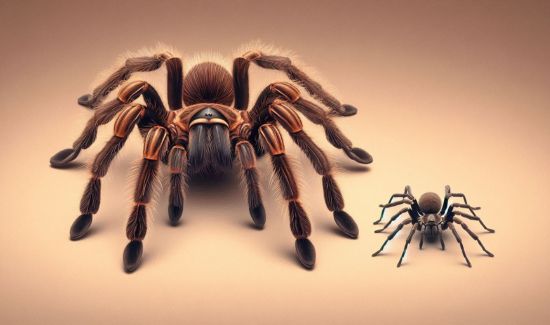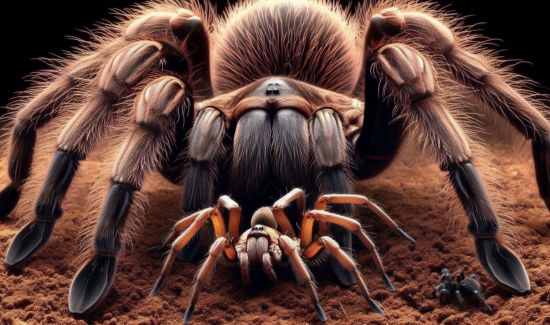Introduction
Table of Contents
When we think of creepy crawlies, spiders are often the first creatures that come to mind. But did you know that tarantulas are a specific type of spider? They’re not just any spider, though—they have unique features and behaviors that set them apart. Understanding the differences between tarantulas and other spiders is not only fascinating but also helps us appreciate these misunderstood creatures. In this article, we’ll dive into the world of tarantulas and spiders, exploring their similarities, differences, and why they’re both amazing in their own ways.
Table of Information: Tarantula or Spider
| Characteristic | Tarantulas | Spiders |
|---|---|---|
| Size | Large, can grow up to 12 inches in leg span | Varies, generally smaller than tarantulas |
| Hairiness | Very hairy, with thick bristles | Less hairy, smoother appearance |
| Venom Potency | Mild, mostly harmless to humans | Varies, some species are highly venomous |
| Behavior | Solitary, shy, rarely aggressive | Varies, can be solitary or social |
| Habitat | Warm regions, burrows in the ground | Diverse, found almost everywhere |
| Lifespan | Long, up to 30 years in captivity | Shorter, usually 1-2 years |
| Diet | Insects, small animals, occasionally birds | Insects, small invertebrates |
What Makes a Tarantula?
Tarantulas are a unique group of spiders that are easily recognized by their large size and hairy bodies. But what exactly makes a tarantula a tarantula?
Size and Appearance
Tarantulas are known for their impressive size. Some species can have a leg span of up to 12 inches, making them one of the largest spiders in the world. Their bodies are covered in thick hairs, which can be intimidating to look at but serve important purposes like sensing vibrations.
Venom and Bite
While tarantulas are venomous, their venom is generally mild and not dangerous to humans. Their bite is often compared to a bee sting. Unlike some other spiders, tarantulas are more likely to run away than bite when threatened.
Lifespan
One of the most fascinating aspects of tarantulas is their long lifespan. In captivity, female tarantulas can live up to 30 years, which is significantly longer than most spiders.
Behavior and Habitat
Tarantulas are solitary creatures, preferring to live alone in burrows. They are mostly found in warm regions, particularly in South America, Africa, and parts of the southern United States. Despite their fearsome reputation, tarantulas are actually quite shy and rarely aggressive.
What Defines a Spider?
Spiders are a diverse group of arachnids found all over the world. With over 45,000 species, spiders come in all shapes, sizes, and colors.
Size and Appearance
Unlike tarantulas, most spiders are much smaller and have a smoother appearance. Their size and appearance can vary greatly depending on the species, from tiny jumping spiders to the larger orb-weavers.
Venom and Bite
The potency of a spider’s venom varies widely among species. While some spiders, like the black widow or brown recluse, have venom that can be dangerous to humans, most spiders have venom that is harmless to us.
Lifespan
Compared to tarantulas, most spiders have a much shorter lifespan. The average spider lives for about 1 to 2 years, although some species can live longer in captivity.
Behavior and Habitat
Spiders can be found in almost every environment on Earth, from the rainforests to your own backyard. Their behavior can vary widely; some are solitary like the tarantula, while others, like the social spiders found in South America, live in colonies.
Key Differences Between Tarantula or Spider
While tarantulas are a type of spider, there are some key differences that set them apart from other spiders.
Size
Tarantulas are generally much larger than most spiders. Their large size makes them more intimidating, but it also means they require more food and larger habitats.
Hairiness
The thick, bristly hair of tarantulas is another distinguishing feature. This hair helps them detect vibrations and can even be used defensively. Most spiders, on the other hand, have smoother bodies with fewer hairs.
Venom Potency
While both tarantulas and other spiders have venom, the potency can vary greatly. Tarantulas generally have mild venom that is harmless to humans, while some spiders have venom that can be quite dangerous.
Lifespan
The lifespan of tarantulas is another major difference. With the potential to live up to 30 years, tarantulas outlive most spiders by a wide margin.

Fascinating Facts About Tarantulas and Spiders
Tarantulas Can Regenerate Lost Limbs
One of the most amazing abilities of tarantulas is their capacity to regenerate lost limbs. If a tarantula loses a leg, it can regrow it during its next molt. This is a rare ability in the animal kingdom and makes tarantulas truly unique.
Spiders Produce Different Types of Silk
Not all spiders spin webs, but those that do can produce different types of silk. For example, orb-weaver spiders create intricate webs to catch their prey, while other spiders use silk to create shelters or wrap their eggs.
Tarantulas Have Urtricating Hairs
Tarantulas have a special type of hair called urticating hairs. These tiny, barbed hairs can be flicked off the tarantula’s body when it feels threatened. They can cause irritation to the skin or eyes of potential predators, giving the tarantula a chance to escape.
Spiders Are Vital to the Ecosystem
Spiders play a crucial role in the ecosystem by controlling insect populations. Without spiders, we would see a significant increase in pests that could damage crops and spread diseases.
Tarantulas Are Popular Pets
Despite their fearsome appearance, tarantulas are actually quite popular as pets. Their long lifespan and relatively simple care requirements make them a favorite among exotic pet enthusiasts.
Conclusion
In conclusion, tarantula or spider are both fascinating creatures that play essential roles in our ecosystem. While tarantulas are a specific type of spider, they have unique characteristics that set them apart. From their large size and hairy bodies to their long lifespan and solitary behavior, tarantulas are truly remarkable. Understanding the differences between tarantulas and other spiders helps us appreciate the diversity of the arachnid world and reminds us that these creatures, though often misunderstood, are vital to our environment.
FAQs About Tarantula or Spider
- What is the biggest difference between a tarantula and a spider?
- The biggest difference is size. Tarantulas are much larger and hairier than most other spiders.
- Are tarantulas dangerous to humans?
- No, tarantulas are not dangerous to humans. Their venom is mild, and their bites are often compared to bee stings.
- Can tarantulas be kept as pets?
- Yes, tarantulas can be kept as pets. They are popular due to their long lifespan and simple care needs.
- Do all spiders spin webs?
- No, not all spiders spin webs. Some hunt their prey actively, while others use silk for different purposes.
- How long do tarantulas live?
- Female tarantulas can live up to 30 years in captivity, making them some of the longest-living spiders.

